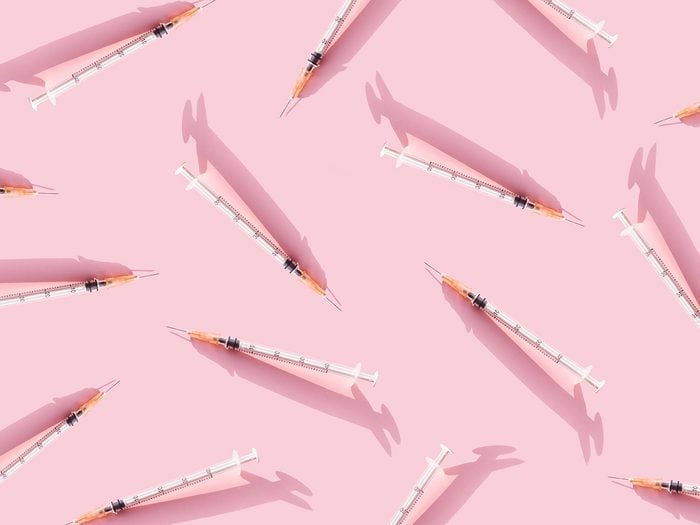What to Know About Xeomin—the “Naked Botox”

Is it really a more natural injectable alternative to Botox? Two experts weigh in.
“I take good care of my skin, hydrate and exercise, but sometimes a girl needs a little extra help,” wrote Gwyneth Paltrow in an Instagram caption for a selfie in September 2020. The post was sponsored by Xeomin Aesthetic, an incobotulinum toxin A the goop founder tried for frown lines. “It’s a uniquely purified anti-wrinkle injection that does not contain any unnecessary proteins,” continued Paltrow in the caption. For that reason, its perceived purity, Xeomin has earned the nickname “naked Botox”—but does that mean it’s actually better than Botox?
We reached out to Susan Poelman, a board-certified dermatologist at Beacon Dermatology in Calgary and Monica Li, board-certified dermatologist at City Medical Aesthetics Center in Vancouver, to learn more about the different types of botulinum toxin type A on the market.
(Related: Is Cosmetic Acupuncture Actually “Natural Botox”?)
What is Xeomin, exactly?
Xeomin is a neuromodulator brand—just like Botox. We commonly refer to the treatment of freezing muscles as “Botox,” but that’s just a brand name (like how we often say “Kleenex” when talking about tissues). The correct term is botulinum toxin type A, and there are three available in Canada: Botox, Xeomin, and Dysport. Allneuromodulators “block the signals from nerves to muscles, causing muscles to relax and thereby reducing the intensity of wrinkles formed from facial expression,” says Li.
What’s the difference between Xeomin, Botox, and Dysport?
Where the brands differ is in their molecular structure. “They’re all botulinum toxin type A, but Xeomin is incobotulinum type toxin A, so it doesn’t have the binding proteins that stabilize the molecule,” says Poelman. Because of this, Xeomin is often hyped as being a more “natural” or “clean” alternative to Botox, but that’s a misnomer, she says. “The binding proteins are thought to make the molecule less reactive,” says Poelman, so if someone were to react or become immune to Botox or Dysport, they may be able to get desired results from Xeomin.
(Related: Curious About Botox? 10 Things You Need to Know First)
Why am I only now hearing about Xeomin?
“Since Gwyneth Paltrow has become kind of the spokesperson for Xeomin, it’s been receiving more attention,” says Poelman, but it’s been around for a while. Xeomin was first approved in Canada for cosmetic use in 2012, and it has been rising in popularity. For years, we’ve heard more about Botox than Xeomin (or even Dysport), due to Botox having been approved in Canada much earlier than Xeomin (in 2001). “With many pop culture references to Botox over the years as well, it is not surprising the brand is well-known and that many considered synonymous with or as a catch-all term for cosmetic injection treatments,” says Li.
How long does Xeomin take to start working and last, compared to Botox?
“Xeomin is probably the quickest in terms of onset,” says Poelman. Patients often see results in three to five days, but in general, all neuromodulators start to kick in around five to seven days. In terms of how long the results last, Li says both Xeomin and Botox last on average for 3-4 months. “It’s important to keep in mind that there are other factors that can affect the duration of treatment results, such as the amount injected, the individual’s rate of metabolism, and the degree of facial expressions,” she says. “Those who are more expressive may find their neuromodulator treatment not as long-lasting as their friends’!”
(Related: 4 Botox Myths You Need To Stop Believing Before You Can Fully Rule It Out)
How do you know which neuromodulator is best for you?
Instead of worrying about choosing the right neuromodulator, Poelman and Li stress the importance of finding an experienced injector. “A board-certified dermatologist or board-certified plastic surgeon will have the most expertise,” says Poelman. “If you have someone who’s experienced, and who knows their anatomy, you’re going to get the best results.” Many dermatologists offer more than one brand of neuromodulator, and it’s up to them to decide which is best for the patient. “A patient’s values, goals, budget, past experiences, and their health history are all taken into consideration as part of an ongoing process to ensure that their treatments are the right fit and works for them,” says Li. This helps doctors deliver the most natural-looking results and help achieve patients’ “preventative and restorative goals,” she says.
What are the possible side effects, and do they differ between the brands?
“Neuromodulators, irrespective of the brand, have a similar side effect profile,” says Li. The most common side effects include minor redness or pain at the injection site, bruising, headache, swelling, and drooping eyelids.
Is there anything else to know before getting Xeomin, Botox, or Dysport?
“With the recent literature, patients can be can feel good about their treatments—that they’re safe and effective,” says Poelman. Plus, neuromodulators been proven to help fight depression, too. “There have been studies looking at depression and neuromodulators, and we know that patients who were treated with neuromodulators actually feel better about themselves,” says Poelman. “Maybe it’s because if you can’t frown, you tend to feel happier, but they’ve studied patients that are treated and found that their mood improved.”
Next: Facial Cupping Will De-Puff Your Face While Relieving Built-Up Tension




